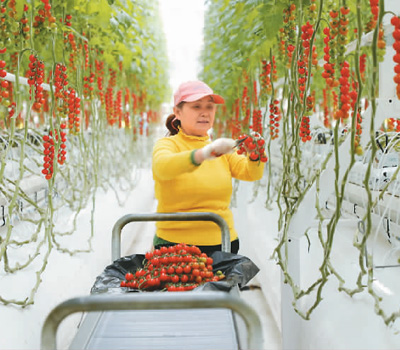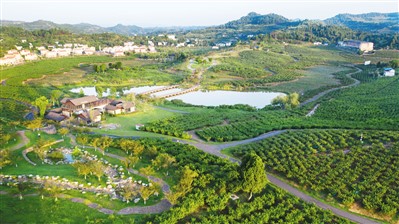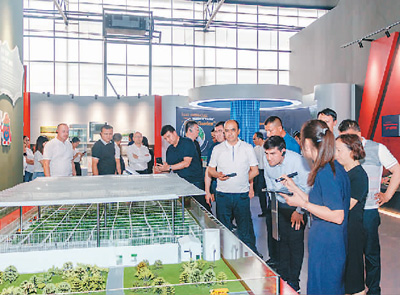Small cherry tomatoes reflect China-France cooperation in science, technology
Workers have recently been busy harvesting cherry tomatoes at an intelligent greenhouse of the circular agriculture zone inside the China-France Agricultural Science and Technology Park in Gaoping district, Nanchong city, southwest China's Sichuan Province.
The intelligent greenhouse is the first semi-enclosed greenhouse that operates efficiently in all weather conditions in southwest China.

A worker harvests cherry tomatoes in an intelligent greenhouse of the circular agriculture zone inside the China-France Agricultural Science and Technology Park in Gaoping district, Nanchong city, southwest China's Sichuan Province. [Photo courtesy of the China-France Agricultural Science and Technology Park]
The park, with a total planned area of 17,000 mu (1,133 hectares), is a key project promoted at the 21st United Nations Climate Change Conference and a national-level project jointly implemented by China and France.
Construction of the park began in February 2017, and an area of 12,000 mu has been completed so far. The park fully showcases agricultural technologies and the wisdom of China and France.
The park's intelligent greenhouse featuring the application of cutting-edge technologies serves as an exemplary project of agricultural technology cooperation between the two countries.
The intelligent greenhouse project, with an investment of 100 million yuan ($13.78 million), occupies 30 mu.
"Unlike traditional cultivation, these cherry tomatoes are digitally managed and controlled throughout their lifecycle. The yield and efficiency are very impressive," said Jiang Min, site manager of the park's intelligent greenhouse. Jiang added that the core equipment and main consumables of the greenhouse are imported directly from France.
The greenhouse applies the world's most advanced environmental control technology and a highly efficient plant cultivation system, enabling intelligent year-round and all-season production.

Photo shows the circular agriculture zone inside the China-France Agricultural Science and Technology Park in Gaoping district, Nanchong city, southwest China's Sichuan Province. [Photo courtesy of the China-France Agricultural Science and Technology Park]
Equipped with sunshade curtains and thermal curtains on the roof, as well as sensors and a weak current system, the greenhouse also ensures the intelligent and precise adjustments of indoor temperature and light intensity, creating the best environment for cherry tomatoes to grow, Jiang noted.
The 1,500-square-meter smart agricultural resource data center serves as the "brain" for all agricultural production in the park. A large screen in the center displays the temperature, relative humidity, and carbon dioxide concentration inside the greenhouse.
"This is the control center for all agricultural facilities in the park, including a water and fertilizer control system for over 3,000 mu of land. A single technician can operate the system," Jiang said.
"Across the park, we've installed sensors that transmit real-time data on the soil conditions and weather back to the data center. The data is then analyzed and displayed on the large screen. Our staff members will be promptly reminded of any abnormalities," Jiang noted.
The park's data center has integrated several smart agriculture platforms, providing data for the traceability of the quality and safety of agricultural products.

Senior civil servants from Uzbekistan visit the China-France Agricultural Science and Technology Park in Gaoping district, Nanchong city, southwest China's Sichuan Province. [Photo courtesy of the China-France Agricultural Science and Technology Park]
"To better achieve integrated water and fertilizer management, we use imported coconut coir as the growing medium for cherry tomato plants and adopt computer-controlled water and fertilizer irrigation. We also recycle and purify rainwater for the growth of cherry tomatoes, saving over 70 percent of water and fertilizers," Jiang said. According to Jiang, coconut coir soilless cultivation is a modern agricultural technique adopted in countries of the European Union in recent years.
The greenhouse is equipped with over 100 sensors, over 1,000 controllers, and more than 20 types of monitoring equipment to constantly acquire and intelligently adjust data on temperature, lighting, water, fertilizers, air, and more, allowing plants to grow in a "comfort zone" all year round.
Over 40,000 cherry tomato plants of more than 10 premium varieties from the Netherlands, Germany, and France are grown in the greenhouse, Jiang said, adding that fresh cherry tomatoes are sold to first-tier cities like Beijing, Shanghai, and Shenzhen.
With an annual production of more than 250 tonnes of cherry tomatoes, the greenhouse provides jobs for over 30 nearby villagers every year, with their per capita annual income reaching 50,000 yuan.
"Through technical cooperation with agricultural enterprises from France and the Netherlands, we installed an intelligent control system in the greenhouse and developed a carbon dioxide capture and utilization system," Jiang said.
This has helped increase the yield and quality of cherry tomatoes while achieving carbon neutrality and carbon utilization, Jiang explained.
According to long-term measurements by Jiang and other staff members, cherry tomato plants in over 20,000 square meters in the greenhouse can fix more than 200 tonnes of carbon dioxide annually, equivalent to planting over 10,000 trees.
The park has also imported bumblebees from Belgium for artificial pollination, increasing the pollination rate while improving the yield and quality of cherry tomatoes.
























